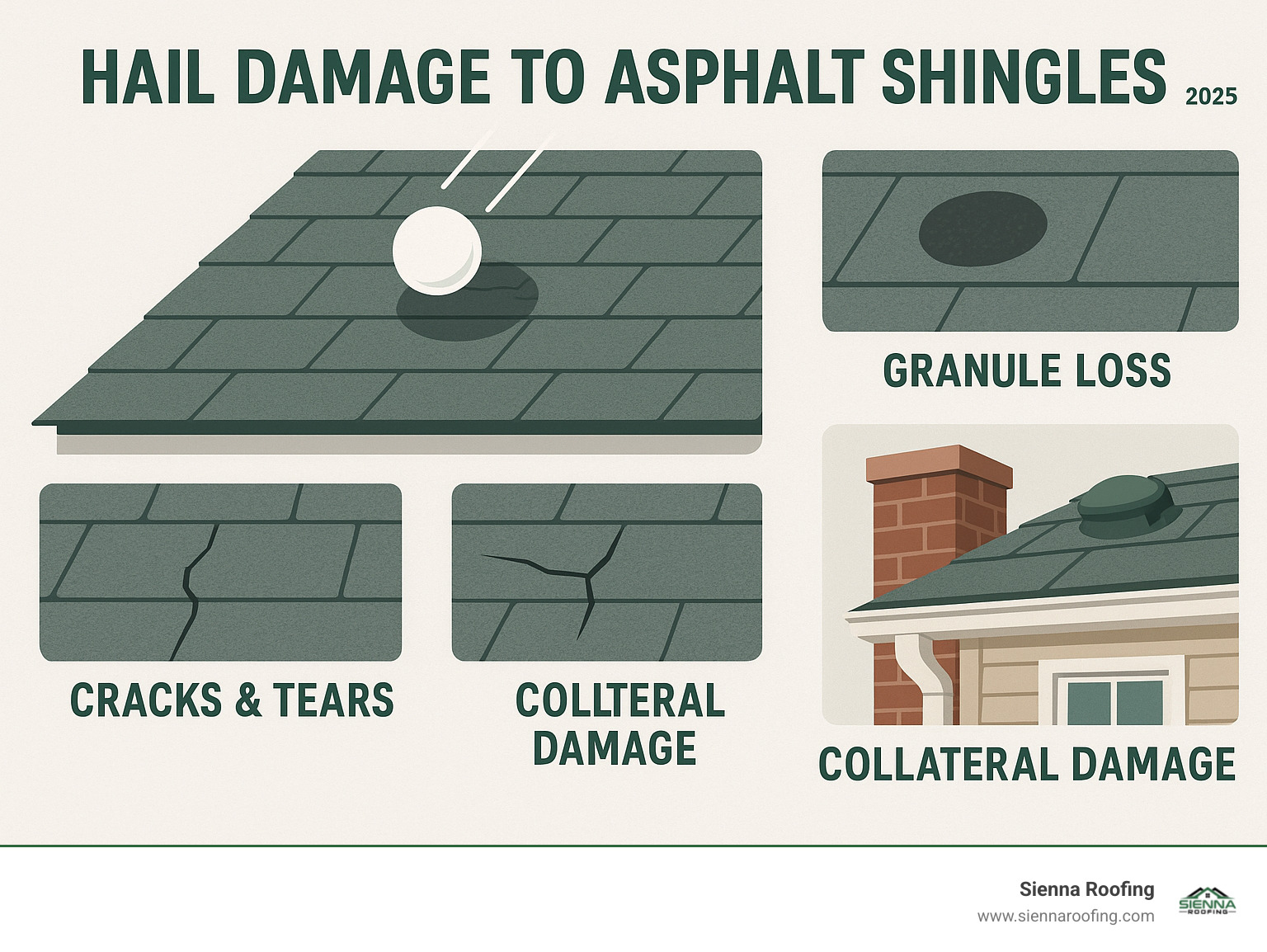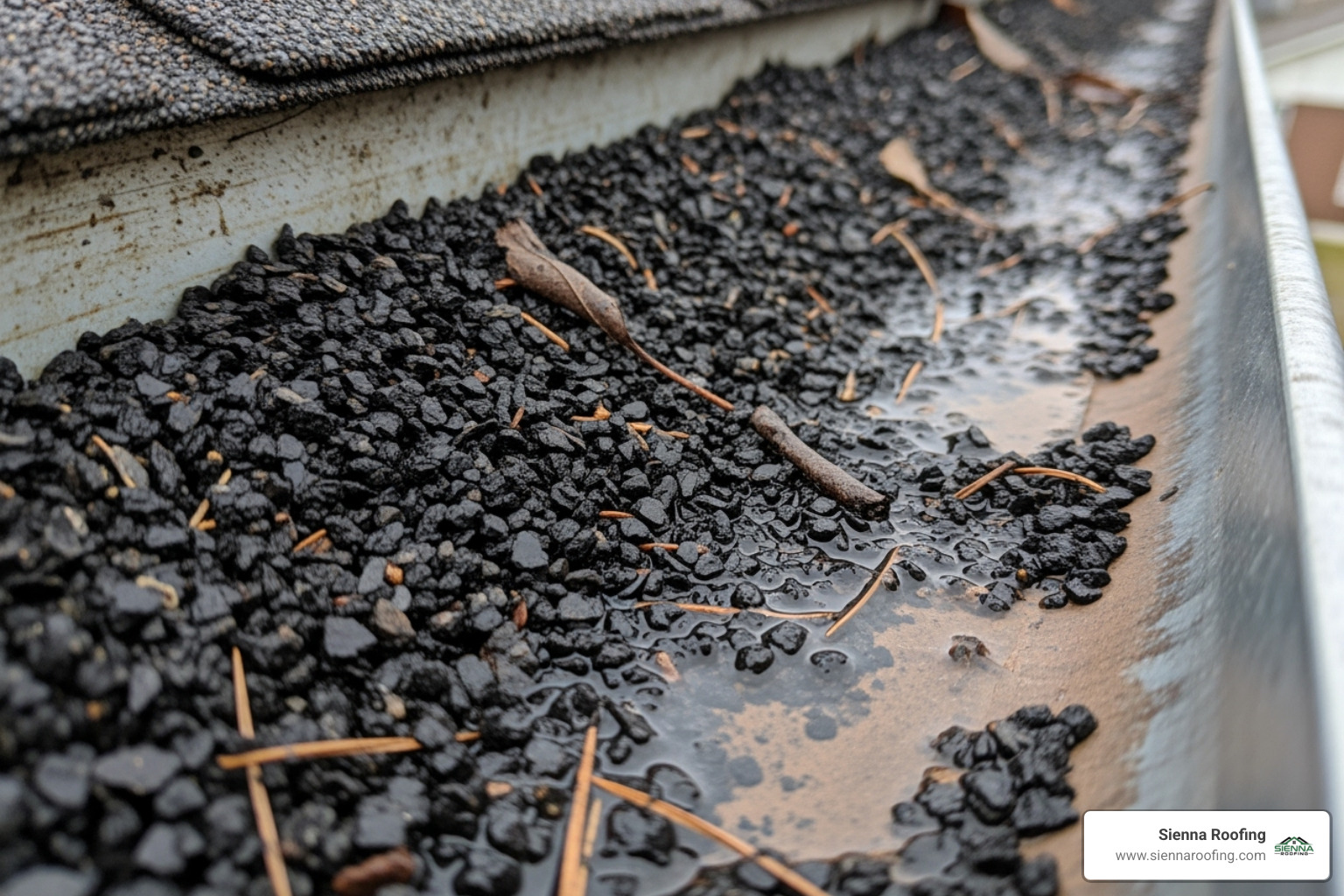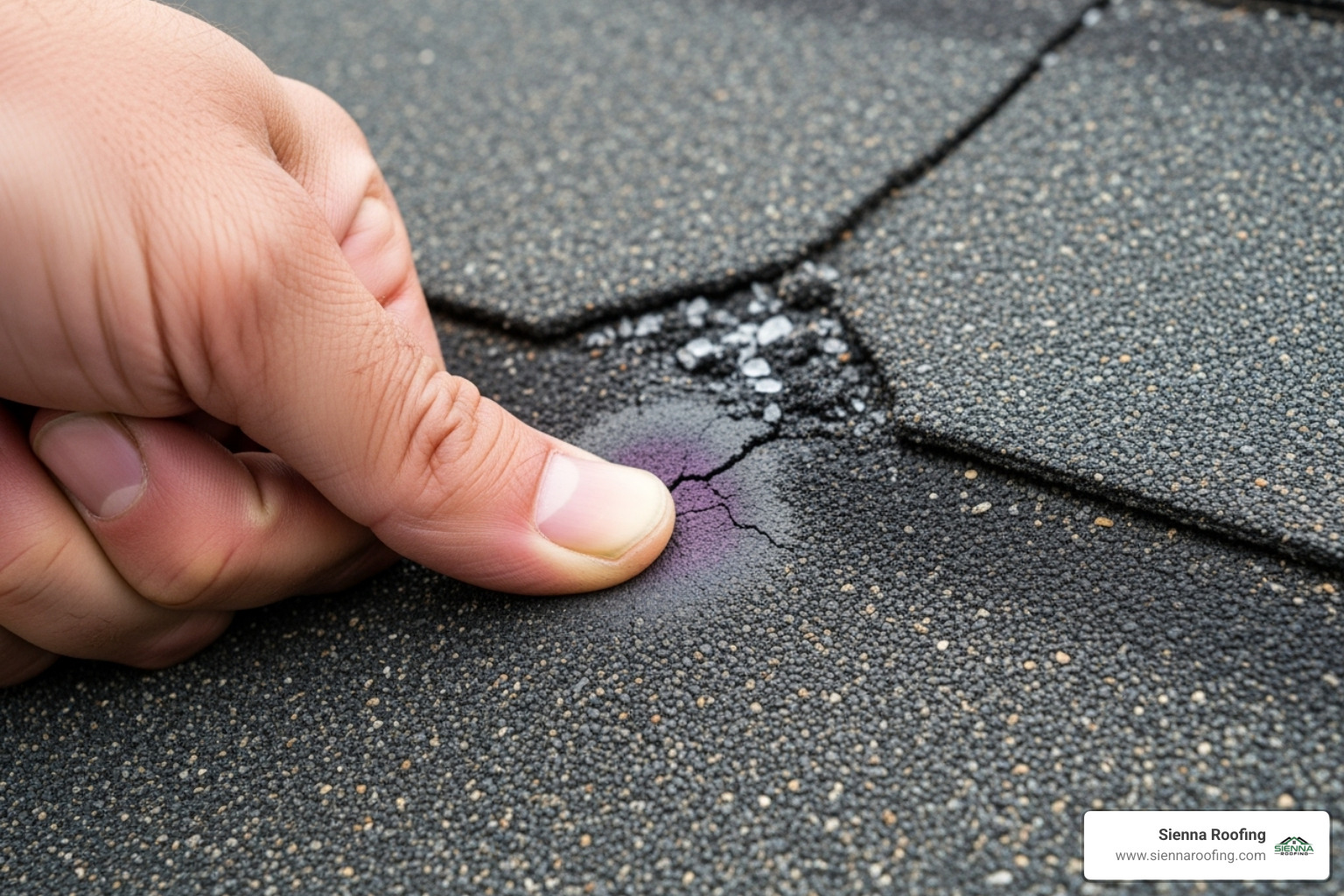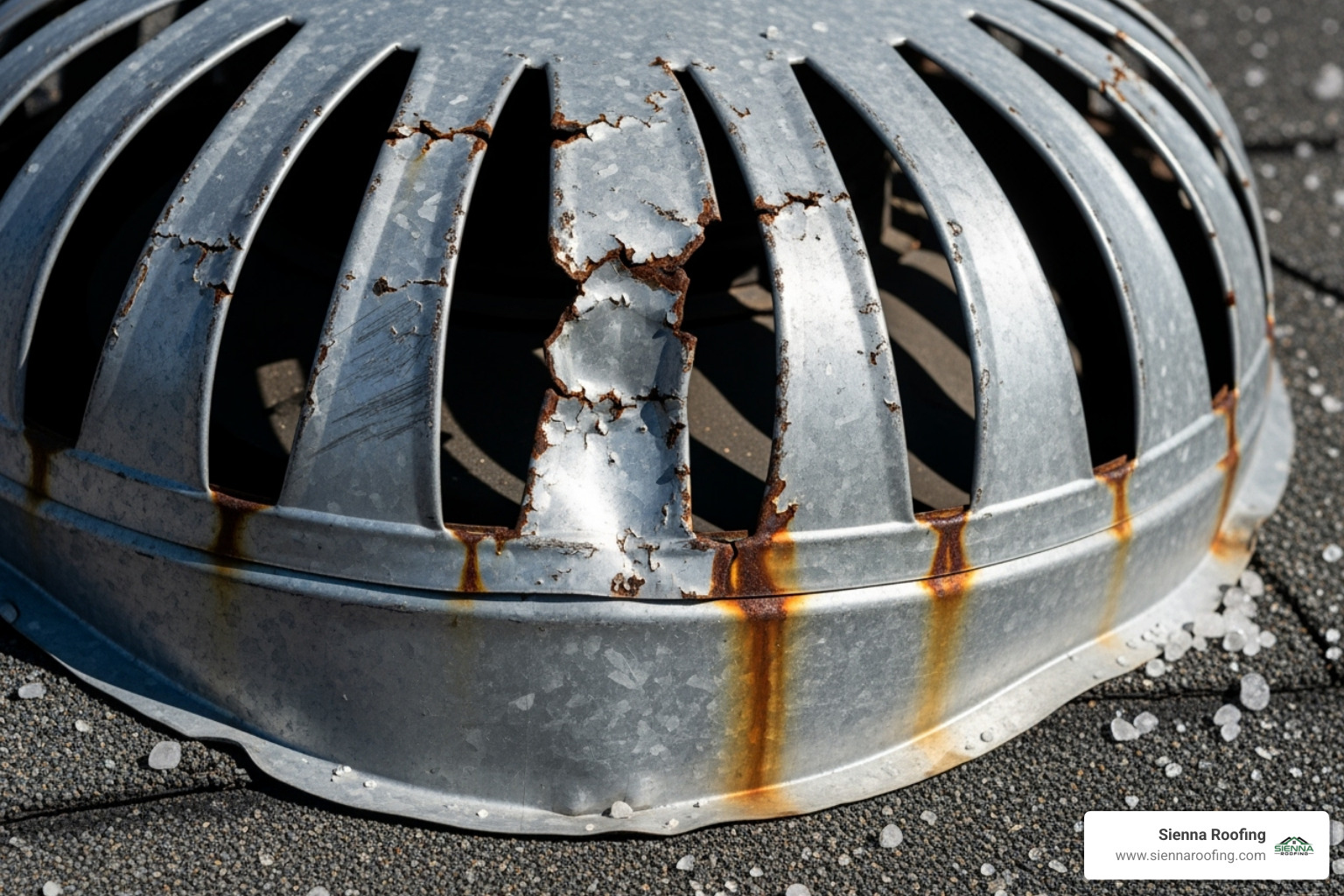Why Recognizing Hail Damage Early Can Save Your Home
Hail damage to asphalt shingles can be deceptive—what looks like minor cosmetic damage on the surface often signals serious problems beneath. After a Texas hailstorm, your roof may have sustained significant damage even if it appears intact from the ground, which is why bringing in trusted roofing experts right away can save you from costly repairs down the road.
Key signs of hail damage to asphalt shingles include:
- Granule loss – Dark spots or bald patches where protective granules have been knocked off
- Shingle bruising – Soft, spongy spots that feel different when pressed
- Cracks and tears – Visible splits or punctures in the shingle material
- Exposed fiberglass mat – White or light-colored backing material showing through
- Collateral damage – Dents in gutters, vents, or siding that indicate hail size and intensity
The challenge is that hail damage often appears subtle at first. According to industry research, even 1-inch hail can cause functional damage to standard asphalt shingles, while smaller hail can weaken shingles over time. What starts as minor granule loss can lead to accelerated aging, UV damage, and eventual water infiltration.
In 2022 alone, there were over 4,400 severe hail events documented in the United States, resulting in billions of dollars in property damage. For homeowners in the Houston Metro area, understanding these warning signs is crucial for protecting your investment and ensuring your family’s safety.
When storm damage strikes, working with a trusted Sugar Land roofing company can make the difference between a quick repair and costly long-term problems. Professional assessment helps identify damage that’s invisible to the untrained eye.
As Andre Castro, CEO of Sienna Roofing & Solar, I’ve personally overseen countless hail damage to asphalt shingles assessments throughout the Houston Metro area over the past five years. My hands-on experience has taught me that early detection and prompt action are essential for preventing minor hail damage from becoming major structural issues.

Understanding Hail and Its Impact on Your Roof
When you hear that distinctive ping-ping-ping sound during a thunderstorm, you’re witnessing one of nature’s most fascinating – and potentially destructive – phenomena. Hail forms when powerful thunderstorm updrafts carry raindrops high into the freezing atmosphere, where they collect layers of ice like a frozen onion.
These ice pellets start small but can grow dramatically as they’re swept up and down within the storm cloud. Each trip through the freezing zone adds another layer of ice. When the hailstone finally becomes too heavy for the updraft to carry, gravity takes over – and a golf ball-sized hailstone can slam into your roof at nearly 100 miles per hour.
The kinetic energy from this impact is what causes hail damage to asphalt shingles. But here’s what many homeowners don’t realize: the severity of damage depends on much more than just the size of the hailstone.
Hail size is obviously important – larger stones pack more punch. But hail density matters too; compact, solid hailstones cause more concentrated damage than softer, less dense ones. Wind speed and wind direction can drive hail at angles, increasing impact force and affecting different sections of your roof differently.
Your roof’s characteristics play a huge role as well. Roof slope influences how directly hail strikes your shingles, while shingle age is critical – older shingles become brittle as the asphalt hardens and loses flexibility. Finally, shingle material quality varies significantly between manufacturers and product lines.
Understanding these factors helps explain why even moderate hailstorms can leave seemingly similar homes with vastly different damage levels. At Sienna Roofing, we’ve seen how these variables combine to create unique damage patterns across the Houston Metro area.
How Hail Specifically Causes Hail Damage to Asphalt Shingles
To understand how hail damages your roof, you need to know what you’re protecting. Asphalt shingle composition includes three main layers: a fiberglass mat base, a waterproof asphalt layer, and protective ceramic granules on top. Each layer serves a specific purpose, and hail can compromise them all.
The most common damage starts with granule displacement. Those tiny ceramic granules aren’t just decorative – they’re your roof’s first line of defense against UV rays, provide fire resistance, and give your shingles their color. When hailstones strike, they knock these granules loose, leaving dark spots where the underlying asphalt is exposed.
This UV ray exposure immediately begins accelerated aging of your shingles. What should have been a 20-year roof might deteriorate in half that time if the damage goes unrepaired. It’s like getting a sunburn that never heals.
Shingle bruising is another serious concern. When hail impacts your roof, it can fracture the fiberglass mat underneath without creating an obvious hole. These bruises feel soft or spongy to the touch because the impact has crushed the shingle’s internal structure. This mat fracturing weakens the entire shingle, making it vulnerable to future weather events.
Larger hailstones cause more obvious damage through cracking and punctures. These create direct breaches in your roof’s waterproof barrier. Even the weakened self-seal strip that bonds shingles together can be compromised, making your roof more susceptible to wind damage later.
All of these issues lead to the same problem: water infiltration. Once your shingles can’t effectively shed water, moisture seeps into your roof deck, attic, and eventually your home’s interior. This creates a cascade of problems including wood rot, mold growth, and structural damage.
What Size Hail Causes Damage?
Here’s the question every homeowner asks after a storm: “Was that hail big enough to damage my roof?” The answer depends on several factors, but we can provide some helpful guidelines based on hail size:
- 0.75-inch hail (dime-sized): Can cause minor granule loss, especially on older or weaker shingles. Functional damage is less common unless the roof is already compromised.
- 1-inch hail (quarter-sized): This is a significant threshold. It often causes noticeable granule loss and bruising, particularly with strong winds. Many insurance companies consider this the functional damage threshold for standard asphalt shingles.
- 1.25-inch hail (half-dollar-sized): Brings a substantial potential for bruising, granule loss, and minor cracking. Damage to gutters and siding is also likely, helping confirm the hail’s intensity.
- 1.75-inch hail (golf ball-sized): Almost guarantees severe damage to standard asphalt shingles, including bruising, cracking, and potential punctures. This is typically the minimum size needed to damage high-quality impact-resistant shingles.
- 2.75-inch hail (baseball-sized) and larger: Causes extreme damage, including lifted shingles, holes in siding, and significant structural impact.
There’s an important distinction between cosmetic damage and functional damage. Cosmetic damage might be visible but doesn’t immediately compromise your roof’s performance. Functional damage, however, reduces your shingles’ ability to protect your home or shortens their expected lifespan.
Even seemingly minor damage can lead to major problems over time. That’s why professional assessment is always recommended after any significant hail event in your area.
How to Identify Hail Damage on Your Roof
After a hailstorm rolls through your neighborhood, your first instinct might be to grab a ladder and scramble up to check your roof. I totally get that urge – your home is your biggest investment, and you want to know what you’re dealing with. But hold on just a minute! Let’s talk about doing this safely and effectively.
Safety should always come first when inspecting for hail damage to asphalt shingles. Roofs can be treacherous, especially after a storm when they might be wet, covered in debris, or structurally compromised. Walking on a damaged roof can actually make things worse – and we definitely don’t want that.
Here’s the smart way to start your inspection: begin from the ground. Walk around your property and look up at your roof from different angles. A good pair of binoculars can be your best friend here, giving you a much closer view without the risk of climbing up. Pay special attention to metal components like gutters, downspouts, and roof vents – these often show damage more clearly than the shingles themselves.
If you’re not comfortable with ladders or feel unsure about walking on a roof safely, please don’t push yourself. There’s no shame in calling in the professionals – that’s what we’re here for! At Sienna Roofing, our comprehensive roof inspection services ensure every inch of your roof gets properly assessed by trained eyes who know exactly what to look for.
Common Signs of Hail Damage to Asphalt Shingles
When we’re hunting for hail damage to asphalt shingles, granule loss is usually the first clue that catches our attention. Think of those protective granules as your roof’s sunscreen – when they’re gone, trouble starts brewing.

Granule loss shows up as dark spots or bald patches on your shingles where the protective coating has been knocked clean off. These exposed areas reveal the dark asphalt underneath, creating a polka-dot effect that’s pretty unmistakable once you know what you’re looking for.
But here’s a pro tip: check your gutters and downspouts. After a hailstorm, you’ll often find piles of loose granules that have washed down from your roof. Older roofs naturally shed some granules over time, but a sudden surge after a storm? That’s your roof crying for help.
Once those granules are gone, your shingles start aging in fast-forward. The exposed asphalt gets hammered by UV rays, leading to accelerated deterioration that can cut your roof’s lifespan dramatically. What should have been a 20-year roof might start failing in just a few years if the damage goes unaddressed.
Bruises, Cracks, and Exposed Matting
Beyond granule loss, hail can deliver some serious structural blows to your shingles. These types of damage are often more subtle but potentially more dangerous.

Shingle bruises are tricky because they don’t always look like much from a distance. These happen when hailstones hit with enough force to fracture the fiberglass mat underneath without creating an obvious hole. If you can safely reach a suspected area, gently press on it – bruised shingles feel soft, spongy, or “give” under pressure. It’s like the shingle has been internally injured, making it vulnerable to future weather events.
Cracks in shingles from hail damage have a distinctive random pattern that’s different from the straight, uniform cracks you might see from house settling or manufacturing defects. These hail-induced cracks often appear scattered around impact points, creating an irregular damage pattern across your roof.
When hail hits really hard, you might see exposed fiberglass mat – those light-colored white or gray fibers showing through the shingle surface. This is a red flag because it means your shingle’s water-shedding ability has been seriously compromised.
In severe cases, especially with large, wind-driven hailstones, you might find actual punctures or tears in your shingles. These are obvious breaches in your roof’s protective barrier and need immediate attention to prevent water infiltration.
Spotting Collateral Damage Around Your Property
Here’s where detective work really pays off. Sometimes the clearest evidence of hail damage isn’t on your roof at all – it’s scattered around your property in the form of collateral damage. These items often show impact marks more clearly than shingles and provide crucial evidence for insurance claims.

Dented gutters and downspouts are like hail damage report cards. Metal gutters show circular dents, dings, and what we call “spatter marks” – discoloration from multiple impacts. You might even notice “innies” (dents pushed inward) and “outies” (dents pushed outward), which can help determine the direction and intensity of the hail.
Damaged roof vents and flashing made from softer metals like aluminum or copper are particularly vulnerable. Check these components for dents, dings, or scuff marks that weren’t there before the storm.
Your siding and exterior paint can tell quite a story too. Vinyl or aluminum siding might show cracks, chips, or dents, while painted surfaces on wood, shutters, or exterior doors often display dings or spatter marks where hail has chipped away the finish.
Don’t forget about window screens – hail can tear holes right through them. Your outdoor air conditioning unit is another tell-tale indicator, as those delicate fins are incredibly susceptible to hail damage and often show numerous small dents.
Even your mailbox can be a witness to the storm’s intensity, especially if it’s metal. Wooden decks or outdoor furniture might show impact marks or discoloration where hailstones struck.
If you find damage on any of these items around your property, it’s a strong signal that your roof has likely sustained damage too, even if you can’t see it clearly from the ground. This evidence becomes invaluable when documenting the storm’s impact and filing insurance claims.
The Risks of Undetected Damage and Navigating Insurance
When hail damage to asphalt shingles goes unnoticed, it’s like having a tiny leak in your boat – you might not see the water coming in at first, but eventually, you’ll find yourself in deep trouble. The reality is that what looks like minor damage today can become a homeowner’s nightmare tomorrow.
The most immediate concern is water infiltration. Even a small area of granule loss or a subtle shingle bruise can compromise your roof’s ability to keep water out. Once water finds its way in, it doesn’t just sit there politely – it spreads, soaks, and causes havoc throughout your home’s structure.
You might first notice water leaks as small ceiling stains that seem to appear out of nowhere. These innocent-looking spots are often the first sign that damaged shingles are allowing moisture to penetrate your roof system. But the problems don’t stop there – water can quickly lead to structural issues as it saturates and rots your roof decking and supporting framework.
Perhaps even more concerning is mold growth. Your attic’s dark, damp environment becomes the perfect breeding ground for mold and mildew once moisture gets in. These unwelcome guests don’t stay confined to the attic – they can spread throughout your home, creating serious health risks for your family.
This is exactly why prompt action with professional roofing storm damage repair makes such a difference. What might cost a few hundred dollars to fix today could easily become a multi-thousand dollar disaster if left unaddressed.
Long-Term Consequences of Ignoring Hail Damage to Asphalt Shingles
I’ve seen too many homeowners learn this lesson the hard way. What starts as minor leaks that seem manageable can quickly escalate into major structural problems that affect your entire home.
When water continues to seep through damaged shingles, it doesn’t just create those telltale ceiling stains – it begins a slow but relentless process of destruction. Attic damage often happens silently, with insulation becoming waterlogged and losing its effectiveness. This means your HVAC system has to work overtime, driving up your energy bills month after month.
The rotted roof decking that results from prolonged water exposure is particularly devastating. The plywood or OSB boards that form your roof’s foundation can become so weakened that they need complete replacement. This isn’t just a roofing issue anymore – it’s a structural problem that affects your home’s safety and stability.
Compromised insulation creates a domino effect of problems. Not only does it reduce your home’s energy efficiency, but wet insulation becomes a breeding ground for mold and mildew. Once mold takes hold, it can spread beyond your attic into your living spaces, requiring expensive professional remediation and potentially causing respiratory issues for your family.
The structural integrity loss that results from ignoring hail damage can be truly frightening. Water damage doesn’t discriminate – it can affect your home’s framing, electrical systems, and even your foundation if left unchecked long enough.
Perhaps most frustrating of all are the increased future repair costs. What might have been a straightforward shingle repair after the initial storm can balloon into a complete roof replacement, extensive structural repairs, and mold remediation. We’re talking about the difference between a few thousand dollars and potentially tens of thousands.
For a deeper understanding of how damaged shingles can affect your home, I recommend reading our comprehensive guide: Don’t Get Shingled Out: Your Guide to Damaged Roof Shingles.
Will Insurance Cover Hail Damage?
Here’s some good news – most homeowners insurance policies do include storm damage coverage for hail damage to your roof. After all, protecting your home from weather-related damage is one of the main reasons you pay those monthly premiums!
However, successfully navigating the insurance claims process requires some knowledge and preparation. Filing a claim starts with proper documentation – and this is where many homeowners make critical mistakes. You need clear photos and videos of all damage, including your roof (taken safely from the ground), any collateral damage around your property, and even the hailstones themselves if you can safely capture them with a ruler for scale.
Don’t wait too long to act. Most insurance companies have claim deadlines – typically around one year from the date of loss. While that might seem like plenty of time, it’s always better to file sooner rather than later. The longer you wait, the harder it becomes to prove that damage was caused by a specific storm event.
You’ll be responsible for your deductible – the amount you pay out-of-pocket before your insurance coverage kicks in. This is typically a set dollar amount or a percentage of your home’s insured value.
One of the most important distinctions to understand is the difference between ACV vs. RCV policies. An Actual Cash Value policy pays out the depreciated value of your roof, which means the older your roof is, the less you’ll receive. A Replacement Cost Value policy, on the other hand, pays enough to replace your damaged roof with a brand-new one of similar quality, without factoring in depreciation. RCV policies are generally much more favorable for homeowners.
Working with adjusters can be tricky territory. Your insurance company will send an adjuster to inspect the damage, but remember – they work for the insurance company, not for you. It’s highly recommended to have your trusted roofing contractor present during this inspection. We can help identify all the damage, including subtle signs that an adjuster might miss, and ensure that the scope of damage is accurately assessed.
Our team has extensive experience working with insurance companies and can help guide you through the entire process to ensure you receive a fair settlement. For more detailed information about navigating this process, visit our comprehensive guide on roofing insurance claims.
Upgrading Your Defense: Hail-Resistant Roofing Options
If you’ve ever experienced the heart-stopping sound of hail pounding your roof, you know exactly why so many Houston area homeowners are making the switch to impact-resistant shingles. After dealing with hail damage to asphalt shingles repeatedly, it just makes sense to upgrade your home’s defense system.
The gold standard for measuring how well roofing materials can handle impacts is the UL 2218 Standard. This testing protocol puts roofing materials through their paces, rating them from Class 1 (basic protection) all the way up to Class 4 rating – the highest level of impact resistance available.
To earn that coveted Class 4 rating, shingles must survive a pretty intense test. Engineers drop a 2-inch steel ball from 20 feet high – twice in the exact same spot – without the shingle cracking, tearing, or losing its integrity. That’s some serious punishment, and it gives you a real sense of what these shingles can handle when Mother Nature throws her worst at your roof.
What makes these shingles so tough? Most impact-resistant options are made with polymer-modified asphalt, often called rubberized shingles or SBS shingles (that’s Styrene-Butadiene-Styrene, if you’re curious). The addition of these polymers transforms regular asphalt into something much more flexible and durable. Instead of cracking under impact like standard shingles, these materials can absorb the blow and bounce back.
This improved flexibility isn’t just great for hail protection – it also helps your roof handle Texas’s extreme temperature swings better. When it’s 105°F in the summer and then drops to freezing in winter, that flexibility prevents the cracking and splitting that can plague standard shingles.
When you’re considering asphalt shingle roofing options, impact-resistant shingles represent a smart long-term investment that often pays for itself over time. Many insurance companies recognize this value too, offering potential insurance discounts for homes with Class 4 roofs.
Benefits of Impact-Resistant Shingles
- Improved hail protection – Significantly reduces the likelihood of damage from hailstorms, potentially saving thousands in repair costs.
- Longer lifespan – The improved durability often extends your roof’s life well beyond standard shingles.
- Potential for lower insurance premiums – Many insurers offer discounts of 10-35% on premiums for Class 4 roofs.
- Increased home value – A hail-resistant roof is an attractive feature for buyers in storm-prone areas like ours.
- Peace of mind – There’s real value in knowing your home is better protected during Texas’s intense storm seasons.
The upfront cost might be higher than standard shingles, but when you factor in the potential insurance savings, reduced repair costs, and longer lifespan, impact-resistant shingles often prove to be the more economical choice in the long run. Plus, you can’t put a price on sleeping soundly during the next hailstorm, knowing your roof is built to handle whatever the sky throws at it.
Conclusion
After walking through the ins and outs of hail damage to asphalt shingles, one thing becomes crystal clear: knowledge is your best defense against costly surprises. We’ve covered how those seemingly innocent ice pellets form in thunderstorms and gain enough power to wreak havoc on your roof, along with the various factors that determine whether your shingles will survive the assault.
The damage itself tells a story – from the telltale granule loss that exposes your shingles to harmful UV rays, to the subtle bruising that feels spongy under your touch, to the more obvious cracks and exposed matting that signal serious trouble. Don’t forget to check around your property for those helpful clues like dented gutters and damaged AC units that often reveal the storm’s true intensity.
Perhaps most importantly, we’ve explored why ignoring these signs is like playing with fire. What starts as minor granule loss can snowball into rotted decking, mold growth, and structural damage that costs tens of thousands more than prompt repairs would have. Your insurance is there to help, but understanding the difference between actual cash value and replacement cost coverage can mean the difference between a smooth recovery and a financial headache.
For those looking ahead, impact-resistant shingles offer a smart investment that not only protects your home but can also lower your insurance premiums and increase your property value.
Here’s the bottom line: hail damage to asphalt shingles rarely announces itself with obvious leaks or missing shingles. More often, it whispers through subtle signs that require a trained eye to detect. Waiting until the damage becomes obvious usually means waiting until it’s become expensive.
At Sienna Roofing, we’ve seen too many homeowners find that “minor” hail damage had been silently compromising their homes for months or even years. That’s why we’re passionate about helping our neighbors in Sugar Land, Missouri City, Katy, Richmond, Pearland, Rosenberg, Rosharon, Friendswood, Webster, Bellaire, and West University catch these issues early.
Don’t let a Texas hailstorm catch you off guard. If you suspect your roof has been impacted, reach out for a professional assessment. Our team provides honest evaluations backed by our 100% satisfaction guarantee. Get help with your storm-damaged roof today – because your home deserves protection you can count on.




